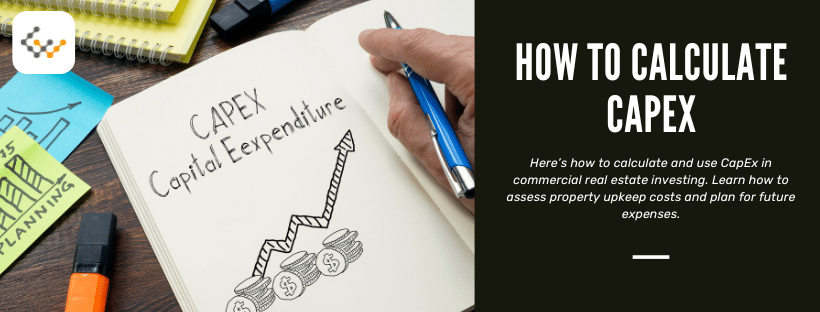Capital Expenditure Formula: How to Calculate CapEx

Commercial real estate investors need a solid understanding of just how much they’re putting into properties and other assets. The capital expenditures (CapEx) formula shows just that. Here’s how to calculate and use CapEx in commercial real estate investing.
What are Capital Expenses (CapEx) in Real Estate?
Capital expenses are the costs necessary for acquiring, maintaining, and improving physical assets. Commercial real estate primarily involves the costs associated with purchasing, maintaining, renovating, and expanding properties.
Other industries might include higher costs for equipment (assembly line machinery) or other infrastructure (e.g. oil pipelines). Some industries are much more capital-intensive than others — with commercial real estate certainly having some of the highest CapEx rates.
Understanding CapEx helps investors know what costs are being put into the growth of their portfolio. It can also show whether operating expenses (OpEx) cover the cost of maintaining properties.
Types of Capital Expenditures
Capital expenditures generally last more than one year. Anything with a lifespan under one year is likely an operating expenditure.
For example, a manufacturer’s materials belong in OpEx, while its equipment belongs in CapEx. Most capital expenditures that commercial real estate investors have fall into one of a few groups:
- Acquisition: Costs associated with purchasing a new property, including purchase price, closing costs, survey and inspection expenses, real estate agent fee, etc. Any subscription for a property screening service would belong in OpEx, since this isn’t an asset.
- Land Improvement: Costs associated with improvements that make land itself more aesthetically pleasing, more functional, or generally higher in value. These could be landscaping costs, paving and hardscaping costs, lighting installation costs, etc. A parking garage wouldn’t be a land improvement cost, but a paved drive and parking lot would be.
- Building Improvement: Costs associated with maintaining, updating or improving existing structures. This could include everything from replacing a roof or renovating units, to adding storage sheds or installing a new swimming pool.
- Building Expansion: Costs associated with building new structures or expanding existing ones. A new parking garage or addition to a building would fall into this category.
- Equipment: Costs associated with maintaining, repairing or replacing major equipment. This is typically an HVAC system, hot water heater, on-site snow removal equipment, or similar items that last for several years.
All of these expenses are for maintenance or improvement that should last more than one year. There’s no standard way of itemizing capital expenditures, so these items can be listed differently at times. Almost all capital expenditures will fall into one of the above categories, though.
What is CapEx Used For?
Capital expenses are used for the maintenance or improvement of physical assets. Real estate investors might use CapEx to:
- Increase Property Value: Renovations and expansions almost always increase property value, while maintenance and repairs also help maintain it.
- Increase Revenue Generation: Improvements and upgrades can increase top-line revenues through additional fees (e.g. parking or storage fees), or by increasing the rents that a property can command.
- Extend Asset Lifespan: Maintaining equipment and buildings prolongs their lifespan, reducing long-term CapEx that’s needed to replace equipment or buildings’ components.
- Safety and Compliance: Sometimes CapEx is necessary to improve the safety of a property, or to remain in compliance with codes.
- Tax Benefits: Sometimes, CapEx can be depreciated over time. Other times, they can’t be directly deducted if an allowed percentage of a structure’s value is depreciated annually. A tax professional can help make this determination.
CapEx vs Operating Expenses (OpEx)
CapEx refers to major investments in physical assets, whereas operating expenses (OpEx) cover the costs associated with the day-to-day operations of a business.
OpEx includes things like property taxes, insurance premiums, management fees, and utilities. Routine repairs and maintenance also fall into this category.
For most expenses, CapEx lasts more than one year, and OpEx lasts under one year. Anything that’s not a physical asset (e.g., software) is usually placed under OpEx.
The primary distinction lies in the treatment of these expenses. CapEx can often be capitalized, meaning its value is depreciated over the asset’s life. Most accounting methods deduct OpEx as a business expense during the period in which the cost is paid.
Methods in Calculating CapEx
There are at least a couple of ways that capital expenditures can be calculated.
- Direct Costs: The actual costs paid for long-term maintenance or improvements. This is the simplest method and is usually only suitable for small real estate properties with minimal CapEx. An investor who owns one single-family home might use this method.
- Cash Flow Statements: Calculating actual costs paid based on cash flow statements. Organized statements will normally list these under an “investing activities” or similar, single heading. Less organized statements may have them interspersed in different categories. This is most useful when there’s an organized cash flow statement that’s clear.
- Net PP&E Increase: Bases CpaEx on the increase in property, plant and equipment (PP&E). This requires some math, but is the most accurate because it also takes into account depreciation. A balance sheet and an income statement are used rather than a cash flow statement.
CapEx Formula
Calculating CapEx using either the direct costs or cash flow statement method is straightforward, requiring adding up all relevant expenses. The Net PP&E Increase method requires a little more math but is still a fairly straightforward calculation:
CapEx = Ending PP&E – Beginning PP&E + Depreciation
Ending PP&E is taken from the last balance sheet in the period under review.
Beginning PP&E is taken from the balance sheet at the start of the period. Depreciation is taken from the income statement rather than a balance sheet.
CapEx Calculation Example
For example, assume a real estate property’s PP&E for the prior period was $800,000, and its PP&E for the current period ended at $950,000. Depreciation was $50,000.
In this case, CapEx would be $200,000 for the period.
CapEx = $950,000 – $800,000 + $50,000 = $200,000
How to Effectively Manage CapEx: 5 Tips
Because capital expenditures can be large expenses, it’s important to manage them well. The following five tips should help:
- Forecast and Budget: Project future CapEx needs and allocate funds in your budget accordingly. This will help manage immediate cash flow when major expenses must be paid.
- Monitor Expenditures: Regularly review CapEx spending to ensure it aligns with strategic goals. CapEx should be a determined percentage of a property’s value and of net operating income (NOI).
- Use Depreciation Schedules: Understand the depreciation schedules to manage tax benefits and asset value. A qualified tax professional should be consulted for assistance with depreciation and taxes.
- Prioritize Preventative Maintenance: Proactive maintenance can often prevent larger, costlier repairs down the road. This is especially true for equipment and roof buildings.
- Negotiate with Suppliers & Contractors: Don’t be afraid to negotiate prices for materials and labor. Securing competitive bids helps control costs. You might be able to get lower bids by planning work for contractors’ slow seasons.
Wrapping Up
Understanding and managing CapEx efficiently is vital for the sustainability and growth of real estate investments. Track capital expenditures and accurately calculate them so you understand what’s being spent on major repairs and improvements for your properties.

